Inspiration Month
One of the hardest things about NaNoWriMo is just keeping up the momentum, especially if, like me, you're something of a discovery writer. Running out of inspiration will bring you to a grinding halt, which is why I like to create at least a skeletal outline before I start. Still, there's nothing like flying by the seat of your pants to get the ideas flowing, and all inspiration has to come from somewhere.

In past centuries writers and artists looked to the gods for inspiration; me, I look to the thousands of hours I've spent consuming media: books, movies, TV shows, video games. We're all exposed to so many more stories, as well as sources of factual information, than our ancestors were, so this month feels like as good as any to honour some of them.
Throughout November I'll be blogging (and posting on social media) about some of the characters and stories that inspire me, and maybe that have inspired you too!
I'll start, though, with non-fiction: the factual topics that go into making the worlds I write about.
Science #
You might think it odd that a fantasy author would put science first as a source of inspiration, but I was a science fiction fan long before I discovered "grown up" fantasy authors like Tolkien. I also have a science degree (zoology), which I draw upon quite a lot in my worldbuilding. The natural world is full of bizarre creatures, many of them with strange behavioural patterns, and mixing and matching just a few of these facts can produce some interesting critters, like the skraylings in my Elizabethan trilogy, Night's Masque.
The skraylings are descended from a fictional cousin of the South American kinkajou (an arboreal mammal related to raccoons), but some of their reproductive behaviour, such as the sexes living separately and choosing mates by the males displaying their prowess, is lifted primarily from birds. Because why not!
History #
No good fantasy writer can avoid knowing at least a little history, even if it's only a passing acquaintance with swords or castle architecture. A more in-depth study of history, however, can provide endless plot ideas - George R R Martin has famously drawn heavily on medieval British history for his tale of powerful houses vying for the throne of a fantasy realm.
I tend to avoid the well-trodden path of the Middle Ages, though. I've set a trilogy in sixteenth-century Europe, have a project on the backburner with an eighteenth-century vibe, and my latest book is set in an analogue of the 1920s. Why limit yourself to a few short centuries in one part of the world, when you have millennia to choose from?
Myths & Magic #
No fantasy novel would be complete without at least a hint of magic. Oh, OK, so Guy Gavriel Kay and K J Parker might disagree, but most fans of the genre love magic, the more complicated and detailed the better (Brandon Sanderson, I'm looking at you!).
Personally I prefer the middle ground. There is magic in all my books, but the 'rules' tend to be a little nebulous, at least from the reader's point of view. There are limits on what magic-users can do, but they're soft limits, based on what I feel will make for an exciting story without the characters becoming so powerful that they can get out of almost any situation scot-free.
So there you have it: the big three non-fiction topics that I turn to when setting up my stories. Next up: five of my favourite fictional heroines!